QR codes are one of the most affordable, effective marketing tools that any business could ask for. It was underutilized for years since its introduction but has since gained momentum, thanks to the increase of smartphone availability and digitization.
Whether you’re a marketer, startup founder, or seasoned entrepreneur, you’ll be surprised at how QR codes improve customer experience, increase conversion and simplify business operation.
Of course, this depends on what information that you’re storing in QR codes and how you’re applying them in business.
What Are QR Codes?
The QR Code, which stands for Quick-Response Code, is the most popular standard amongst 2-Dimensional barcodes. Chances are, you’ve come across QR codes when purchasing tickets, browsing through brochures, or visiting trade events.
QR codes are squarish and bear three identical markers at the corners, that stick out from the rest of the pixels. These markers help the scanner to detect the edges of a QR code. Within the scannable area, the QR code is filled with smaller black and white spaces, which contain the encoded information.
Here’s an example of a QR code that has ScanMeFindMe’s URL encoded into it.

It’s also interesting to note that QR codes are built with an error-correction algorithm. Depending on the size and information stored, a QR code is still readable even if it has up to 30% of its area covered.
For marketers, QR Code’s robustness is a branding opportunity. It opens up the possibility of placing a logo or icon in the middle of the QR code, without compromising its integrity.
It’s recommended to use a professional QR generator to insert a logo into the code. It reduces the risk of making mistakes that make the QR code unreadable.
How Much Information Can They Store?
QR codes are a revolutionary improvement from the single-dimensional barcode, particularly in terms of storage size. A QR code stores up to 4,296 alphanumeric characters or 7,089 numbers, while most 1D barcodes can only manage up to 20 numeric characters. QR codes are also capable of encoding non-Latin symbols like Kanji and hieroglyphs, but this decreases its data capacity.
For a better comparison, it is possible to fit in all the basic details (name, email, address, phone number) of a customer in a QR code. This is not possible if you’re still using the age-old 1D barcode.
However, stretching the QR code to its capacity means it will have tinier and denser pixels. This means that you’ll need a larger print area, or low-resolution cameras may have trouble decoding the QR code.
What Happens When You Scan A QR Code?
There’s no better time to make QR codes part of your marketing plan. That’s because almost everyone seems to own a personal QR code scanner, i.e. their smartphone.
You don’t need a special, dedicated barcode scanner to decode a QR code. If you’re using an iPhone, the camera is built-in with a QR code scanner. Meanwhile, Android users are required to download a QR scanner app, if their smartphone models do not have an intergrated QR scanner.
To scan a QR code, launch the QR scanner app and align the QR code to the designated scanning area. The camera will automatically capture the QR code and retrieve the encoded information, which usually contains texts and numbers.
Now, it’s hard to imagine how plain text and numbers can do wonder in marketing but it does when your audience own a smartphone. It allows QR codes to be used interactively and creatively by making the smartphone respond uniquely to different types of information.
This is done by including formatted text like ‘mailto:’ or ‘tel:’, which instruct the phone to send an email or dial a number respectively, into the QR code. Of course, neither of the actions are carried out automatically without your confirmation.
Static vs. Dynamic QR Codes
Generally, there are two types of QR codes.
Static QR codes imply that the information encoded within is fixed. You can’t edit what is eventually shown to the users.
For example, you can encode WIFI credentials into a QR code. When the users scan the QR Code, it will automatically connect to the WIFI. However, if you’ve changed the WIFI password, you’ll need to generate a new QR code.
Meanwhile, dynamic QR codes contain a short URL that redirects to a website or webpage. While the link is fixed, the information that is displayed on the browser is not. You can make changes to the landing page as you deem fit without a new QR code.
Furthermore, you can incorporate analytics with dynamic QR codes. By doing so, you can track stats like the number of scans, and originating locations. These numbers are helpful in measuring and finetuning your marketing campaign.
Common Types Of Information Stored In QR Codes
Here’s a list of what you can store in a QR code if you’re using our QR code generator.
- URL - The QR code contains a link to your webpage which can be launched in a browser.
- Phone - A phone number is encoded into the QR code. When scanned, it brings up the phone app and automatically pre-fills the phone number.
- SMS/ Whatsapp - Stores the recipient’s phone number in the QR code. Opens up the respective text messaging app with the pre-filled number when scanned.
- Facebook/Twitter - The QR code contains the link to the social media page. Scanning the QR code opens the page in a browser or the respective app if it’s installed.
- WiFi - Stores your WiFi credential. Comes in handy if you’re running a cafe. No more handing tiny slips of your WiFi password.
- Email - Contains an email address and automatically triggers an email app with prefilled recipient’s address when scanned.
- Crypto - Stores your cryptocurrency wallet address in the QR code.
- Contact - The QR code contains your personal information, encoded in Vcard or MeCard format.
- Events - Contains information about an event that will be saved in your calendar.
Storing Information With Dynamic QR Codes
Scanning a QR code is easy, but how do you create one that holds different types of information?
No, you don’t have to be a programming wizard to generating QR codes. Not when you have access to our QR code generator.
Here are the different types of information that can be stored with QR Codes when you’re using ScanMeFindMe Pro
Short URL With Dynamic QR codes
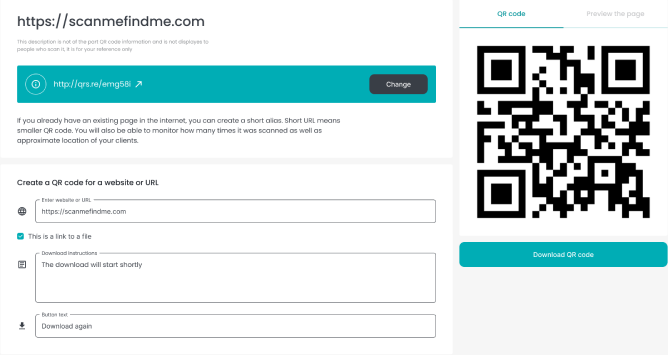
You can create a short URL and encode it into a dynamic QR code. The URL redirects users to the destination link. The destination link, often a website or webpage, can be changed without altering the original QR code.
Contact Card With Dynamic QR codes
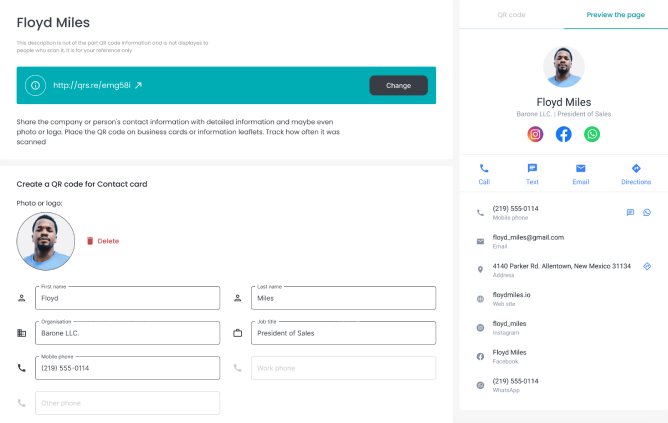
ScanMeFindMe allows you to store personal information, an uploaded photo and social network links with a dynamic QR. It encodes the short URL into the QR, which opens up a webpage displaying the contact information when scanned. This contact information can then be saved directly into users contacts.
Files With Dynamic QR codes
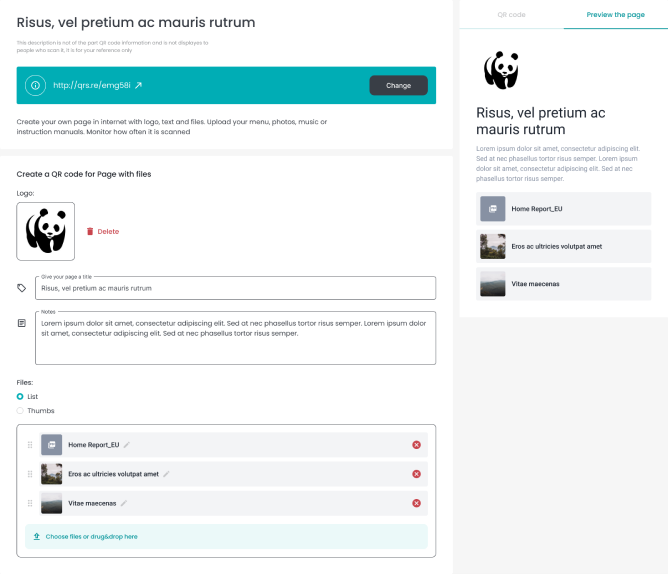
Dynamic QR codes also allow you to share downloadable resources on a webpage. You can upload files and create a QR code that points to the resource page. When users scan the QR code, they will be redirected to the page containing the files.
Managing Dynamic QR Codes With ScanMeFindMe Pro
Once you’ve created a dynamic QR code, you can manage it with ease on the dashboard.
If you need to download the QR code, just click on the Download QR button and you’ll be presented with several image options and advanced page settings.
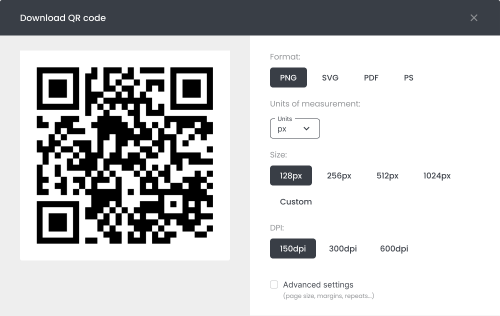
You can view, sort, tag, filter and search dynamic codes that you’ve created on the dashboard.
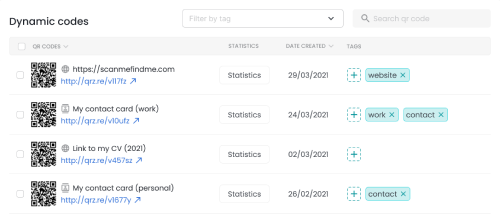
One of the reasons why dynamic QR code is an effective marketing tool, is its ability to track who scanned the QR, when and where. You’ll have access to statistics, charts and reports that will help you improve your targetting strategies and reach more potential clients.
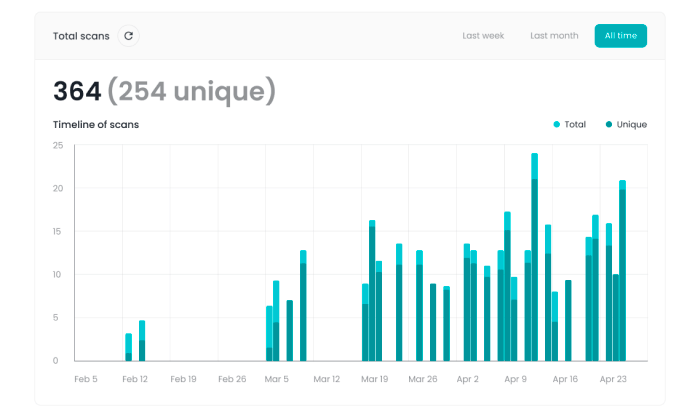
The bottom line is, ScanMeFindMe Pro gives you exclusive access to features like
- Generate dynamic QR codes.
- Use your own templates.
- View who scans your QR codes, when and where.
- More download formats and advanced settings.
- Save personalized QR code presets.
- Use our QR Code generator API from your application.
- Save and manage generated QR codes.